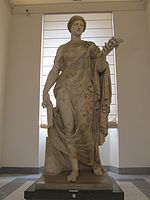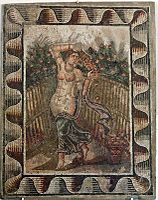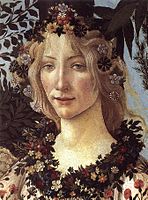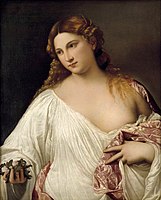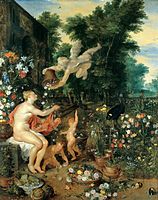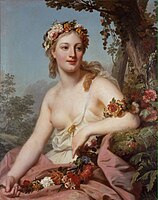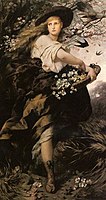Flora (mythology)
| Flora | |
|---|---|
Goddess of flowers and spring | |
Carpus | |
| Equivalents | |
| Greek equivalent | Chloris |
| Oscan equivalent | Fluusa |
| Religion in ancient Rome |
|---|
 |
| Practices and beliefs |
| Priesthoods |
| Deities |
|
Deified leaders: |
| Related topics |
|
Flora (
.Etymology
Look up Flora in Wiktionary, the free dictionary.
The name Flōra descends from
Proto-Indo-European *bʰleh₃ōs ('blossoming').[3]
Festival
Her festival, the
Flora's Greek equivalent is Chloris,[8] who was a nymph. Flora is married to Favonius, the wind god also known as Zephyr, and her companion was Hercules. According to the legend, Flora ran away from Favonius, but he caught her, married her and gave her dominion over the flowers.[9]
Flora achieved more prominence in the neo-pagan revival of Antiquity among Renaissance humanists than she had ever enjoyed in ancient Rome.[citation needed]
Music
Flora is the main character of the 1894 ballet The Awakening of Flora.
Sculpture
There are many monuments to Flora, for example in
Szczecin
(Poland).
-
statue of Flora at Orangerie Kassel, around 1703
-
Flora Farnese (Naples), mid-18th century AD
In art
-
Ancient Roman mosaic of Flora in the Carthage National Museum
-
Flora on a gold aureus of 43–39 BCE
-
Detail of Flora fromPrimavera by Botticelli, c. 1482
-
Flora by Titian, 1515
-
Idealized Portrait of a Courtesan as Flora by Bartolomeo Veneto, c. 1520
-
Flora by Francesco Melzi, c. 1520
-
Flora and Zephyr, by Jan Brueghel the Elder and Peter Paul Rubens, 1617
-
Flora by Claude Vignon, 1650
-
Flora by Rembrandt, 1654
-
Flora or Hebe by Alexander Roslin, 18th century
-
Flora by Valentine Walter Bromley, 1874
-
Flora by Ferdinand Keller, 1883
-
Flora by Mosè Bianchi, 1890
See also
References
- ^ "Flora". Myth Index. Archived from the original on 2016-05-03.
- ^ H. Nettleship ed., A Dictionary of Classical Antiquities (1891) p. 238
- ^ a b de Vaan 2008, pp. 227–228.
- ^ ISBN 0517004046.
- ^ P/ Green ed., Juvenal: The Sixteen Satires (1982) p. 156
- ^ H. J. Rose, A Handbook of Latin Literature (1967) p. 151
- ^ H. Nettleship ed., A Dictionary of Classical Antiquities (1891) p. 238
- ^ Smith, s.v. Chloris (3).
- ISBN 0-631-13209-0.
Bibliography
- Smith, William, Dictionary of Greek and Roman Biography and Mythology, London (1873). Online version at the Perseus Digital Library.
- ISBN 9789004167971.
Primary
- Ovid, Fasti V.193-212
- Macrobius, Saturnalia I.10.11-14
- Lactantius, Divinae institutions I.20.6-10
External links
- The Warburg Institute Iconographic Database (images of Flora)
 Media related to Flora (dea) at Wikimedia Commons
Media related to Flora (dea) at Wikimedia Commons- . . 1914.
- . Encyclopædia Britannica (11th ed.). 1911.
- The Obscure Goddess Online Directory: Flora


